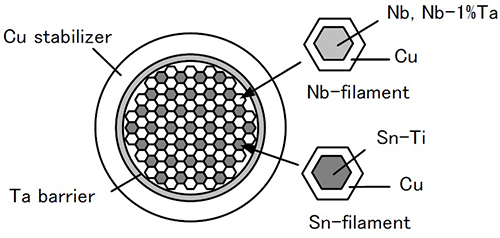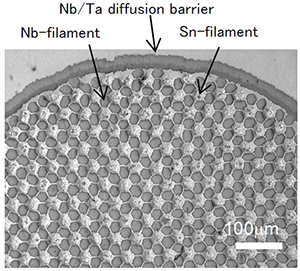2012 The former Hitachi Cable News Release
Information (including product prices, product specifications, details of services, launch dates, inquiry information, and URLs) contained in this news release is current as of the date of the press release but is subject to change without notice. Please note that details may differ from those effective on the search date.
Development of Nb3Sn superconducting wire
with about 1.5 times higher critical current density
Hitachi Cable is announcing the successful development of a niobium-tin (Nb3Sn) superconducting wire*1 with about 1.5 times higher critical current density*2, achieved through the use of an internal-tin process*3 and single-stacking structure.
Nb3Sn superconducting wires are widely used for superconducting magnet systems generating strong magnetic fields in nuclear magnetic resonance (NMR) analytical systems and nuclear fusion facilities such as the International Thermonuclear Experimental Reactor (ITER). They are manufactured mainly using a method called bronze-process. In the bronze-process, the billet incorporating many niobium (Nb) cores in bronze (Cu-Sn alloy) is processed into thin wire by extrusion and drawing processes. Then, the resultant multi-filamentary thin wire is formed to Nb3Sn superconducting wire by heat-treatment.
In order to realize high precision of analytical systems, it is necessary to increase the critical current density of superconducting wire. In the bronze-process, the concentration of tin (Sn) in bronze has been increased to improve the critical current density. But further improvement is limited because of the solubility limit of tin (Sn) in bronze, so development of a new manufacturing process is strongly required.
Hitachi Cable succeeded in developing an Nb3Sn superconducting wire with about 1.5 time higher critical current density by using an internal-tin process and single-stacking structure.
We have developed a new type of internal-tin wire with a simple cross-sectional structure, which can be manufactured using a simple fabrication process. A remarkable characteristic of this wire is that the multi-filamentary wire is structured with mono-filamentary niobium (Nb) elements and mono-filamentary tin (Sn) elements. Compared to the conventional bronze-process, this process can realize a high critical current density because it has higher concentration of tin. In addition, the constituting materials (Nb, Sn, and Cu) have better workability than bronze, which allows the intermediate annealing process to be skipped. This means that wire can be manufactured in a shorter time than the bronze-process.
We have successfully manufactured an Nb3Sn superconducting wire with a diameter of 1.31 mm and length of 5 km containing 840 Nb filaments and 421 Sn filaments. The result of measurement of superconducting properties showed the critical current density of 345A/mm2 in a magnetic field of 18T (tesla), which is about 1.5 times higher than that of the bronze-processed wires.
Hitachi Cable is committed to working on research and development of superconducting wire to further improve their critical current density and expand and enhance our superconductivity businesses.
Cross-section of the Nb3Sn superconducting wire developed this time
Photograph showing a cross-sectional view of Nb3Sn superconducting wire with a diameter of 1.31mm
| *1 | Compared with an Nb3Sn superconducting wire manufactured by Hitachi Cable using the bronze process in an 18-tesla magnetic field. |
| *2 | Critical current density is the maximum current at which an electric current can flow under zero resistance per unit area. |
| *3 | The "internal-tin process" is a process to produce superconducting wire by assembling tin and niobium in copper, with high critical current density properties. |

